
![]()
![]()
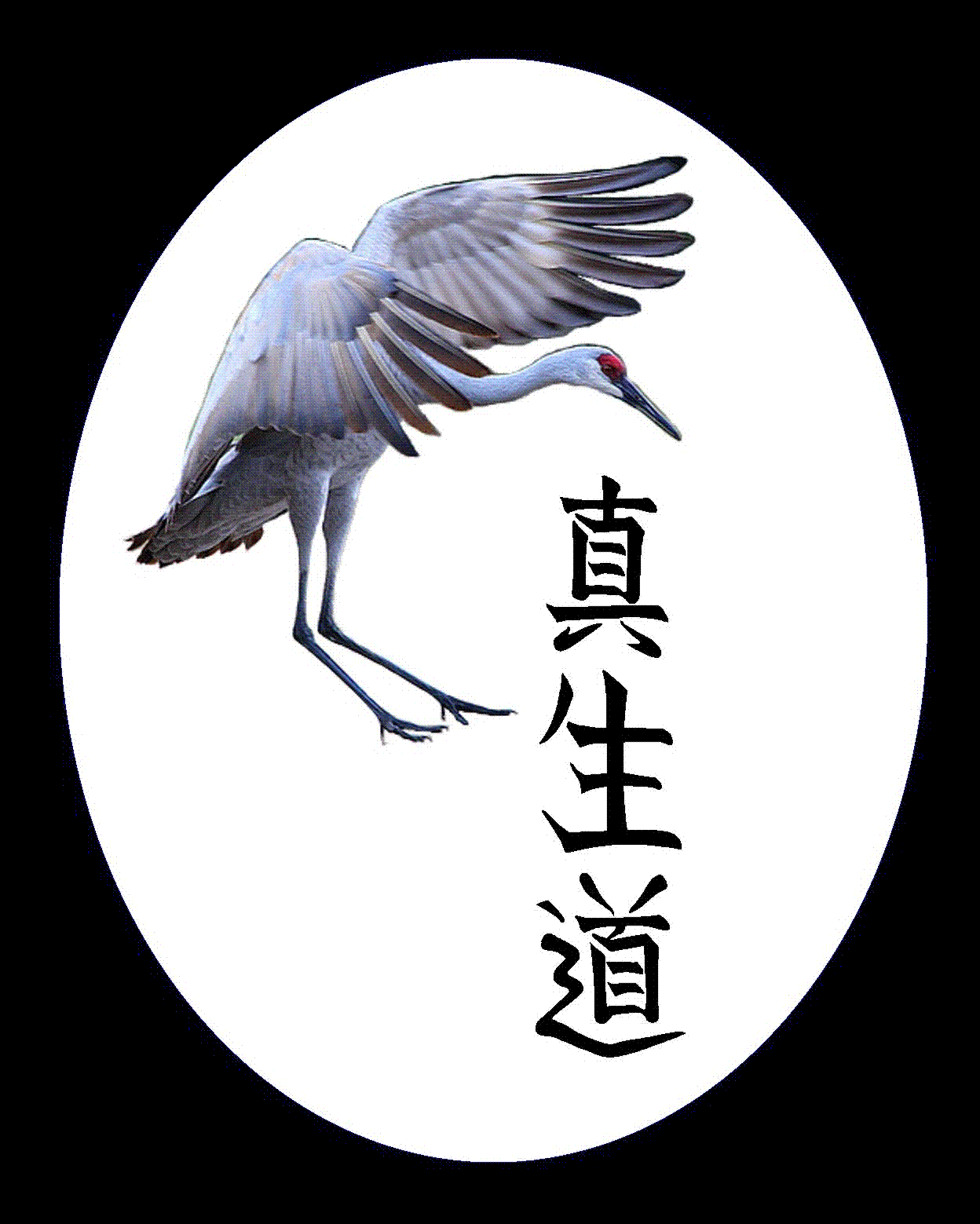
Headingley Karate
|
|
|
Principle Driven Kata
What is the purpose of kata? A simple question, but a quick trawl through various books on Karate shows that few authors or teachers actually attempt to provide an answer. Most will stress the importance of kata, calling it the ‘soul of Karate’ but don’t say why or how. Where a purpose is given it is usually that kata is simply an opportunity to practice a sequence "combining the attacking and blocking techniques of Karate" (Suzuki 1967). To me this makes little sense, we can just practice our basics, we can even put the basics together in endless combinations. Its not at all clear what kata practice can add to this.
I propose looking at kata in a rather different way - a way that consistently explains the purpose of each and every move. My view is simply that the purpose of kata is to enable us to practice not techniques, but principles. This is not a new idea. But where this approach differs from many others is that
- it explains every single kata movement, and
- all of the explanations for all of the movements are consistent with each other.
The principles themselves fall into two categories:
- principles of power generation – how to use the human body to generate maximum power whilst maintaining stability.
- tactical principles – how to use that power to attack and defend against an assailant
To further compound the problem, there are all the variations in kata to be considered. In my own training I’ve attempted to examine older versions of the kata, in order to see past the modern changes that occurred during the 20th century. This has been a rewarding process, but also at times a frustrating one. Looking at just one kata it is possible to find a myriad of variations in performance between the different styles. In some of the older Okinawan systems it seems that almost every practitioner has their own unique version of each kata. But which version is correct? Which one shows the real applications? They can’t all be right, can they?
I believe that all of these questions can be answered by looking at the kata in terms of their power generation and tactical principles, as follows.
Principles of Power Generation
It has been stated by several authors that there are “no blocks in kata” (Dillman & Thomas 1994). I will go one step further. There aren’t any kicks, punches or strikes either. There are only methods of moving the human body in a powerful and stable way. What you then choose to do with those movements – or rather, how you apply the principles - is up to you. The purpose of practising kata is simply to enable you to practice and internalise those principles.
To illustrate this approach I will look at a kata familiar to many Karate practitioners, regardless of style. That is Pinan Nidan, or Heian Shodan as it is known in the Shotokan tradition. It is frequently the first kata that new students are required to learn. Practitioners of other arts may not recognise the name but would probably recognise the kata, or at least most of the movements it contains (for example, practitioners of Taekwondo and Tang Soo Do will recognise Pinan Nidan as the kata that gave birth to the forms Chon-Ji, Taegeuk II Jang, Palqwe II Jang and Pyung-An Cho-Dan). There are many variations of the kata but they almost all revolve around the following movements:
- Lunge punch (oi-zuki / jun-zuki)
- Rising block (age-uke / jodan-uke)
- Downward sweep (gedan-barai / gedan-uke)
Before continuing, it is worth noting one significant difference between the way that I am considering power generation and the way it is usually thought of in striking arts. I am not only concerned with how much power is delivered at the end of each movement, but also how much power can be applied during the whole movement. The reason for this will become clear when we look at some examples.
1. Lunge punch
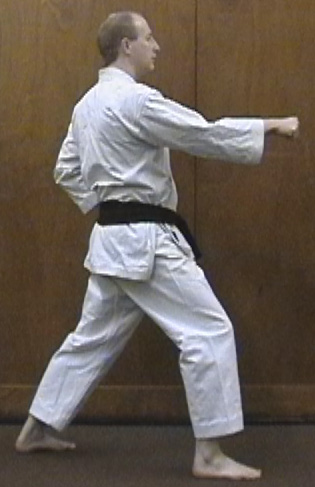
|
There are a number of principles of power development embodied within this movement:
- Pushing and pulling – pushing with one hand while pulling with the other (ie. moving the hands in opposite directions) must be stronger than pushing with one hand alone. Note though that for this to work both hands must be in contact with the enemy, not just the pushing hand.
- Forearm rotation – Almost all arm movements can made more forceful if combined with forearm rotation. A full exploration of this subject would require an in-depth examination of both the anatomy and neurology involved. It must suffice here to note that:
- Elbow flexion (bending) and supination (rotating the forearm to be palm up) are generally mutually supportive, ie. each movement becomes stronger if you perform them simultaneously.
- Elbow extension (straightening) and pronation (rotating the forearm to be palm down) can be mutually supportive in the same way.
- Use a forward stance to act as a stable platform when pushing forwards. I’m sure this is obvious to most martial artists so it warrants no further explanation here.
- Step forwards to add bodyweight to pushing movements. Although there are various ways of stepping used in different styles, a fairly obvious one is to throw or drive the bodyweight forwards to add power to a technique.
- Keep your hips low while stepping forwards. For many years it was far from obvious to me why this should be stronger than allowing your hips to bob up and down as you step. And I’m certainly not the only one to be unconvinced. The top people in Taekwondo evidently questioned this dogma at some point, as it’s a characteristic of Taekwondo techniques to deliberately move up and down as you step forward in stance (what they call ‘sine wave’). Their rationale is to add bodyweight into the strike at the end of the movement. Clearly there are differing views on this subject, but it’s not just the end-point of the movement that I’m concerned about here. My concern is being stable and being able to apply power not only at the end point, but also while you are stepping. Rather than explore the mechanics of this situation it is easier to carry out a simple test to see which way works best. Have a training partner who is roughly your own weight resist your push while you press on their chest with your lead hand. Now step forwards keeping your arm extended, continually pressing on your partner’s torso. The first time allow, encourage even, your hips to rise and fall as you step. You will find you just bounce off your partner’s chest and lose your balance. Now try again but this time keeping your hips low. You should now have no difficulty stepping through and pushing your partner off balance.
I could go on. There are certainly other principles embodied in this movement (keeping the elbows close to the body, the shoulders relaxed etc.) but these are common to just about all Karate movements so I shall leave the list there.
2. Rising Block
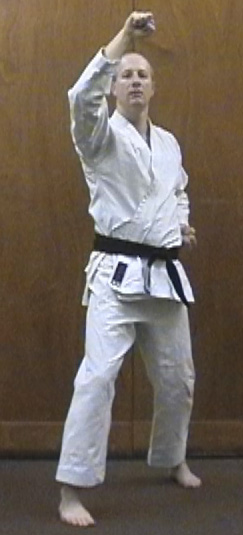
|
- Pushing and pulling – this is basically the same idea as with the lunge punch but, where the punch emphasises pushing/pulling more or less horizontally forwards the power in the rising block is directed more vertically. In other words, push up with one arm and pull down (to the hip) with the other.
- Pushing and pulling sideways – secondary to pushing/pulling vertically there is an additional direction to consider. The rising arm pushes out from the centreline across the body and the descending arm pulls out across the body to the hip.
- Two other principles already noted are (i) keeping the elbow down and close to the body and (ii) pronating the ‘blocking’ arm. It is essential to coordinate these two movements with the pushing and pulling mentioned above in order to develop a powerful movement. When observing students practising rising block incorrectly, it generally seems to be these two aspects where the problems lie.
3. Downward Sweep
This is another movement that can be found in many different arts. In the chamber position the ‘blocking’ arm is first brought to the opposite shoulder while the other arm is extended in front of the body. Then the ‘blocking’ arm sweeps down and across the body while the other hand retracts. As with rising block I shall not consider the chambering movement for the time being and just focus on the second part of the technique. In the kata this movement occurs several times, each time being combined with turning the body to face a new direction. As before, there are a number of principles in common with other movements. In particular, note the consistent way in which forearm rotation is used - the sweeping arm pronating as it extends and sweeps down, the retracting hand supinating. The principles of power generation specific to the downward sweep are:
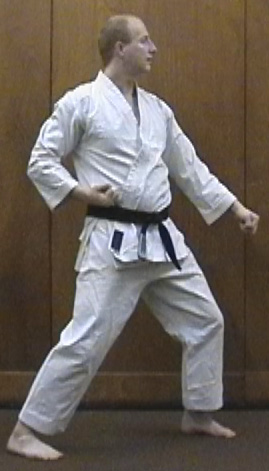
|
- Pushing and pulling – but this time it is the push that is directed downwards and the pull upwards (to the hip). In addition, note how there is the same lateral pushing and pulling as found in rising block.
- Turning the body – the whole body can be rotated in order to add bodyweight to the sweeping movement. As the kata shows, the body can be rotated through a range of different angle for essentially the same effect. It also shows that the turn can be executed in more than one way. For example, in the first downward sweep of the kata, you step backwards and turn after having punched. This demonstrates the principle of using the bodyweight to pull back before sweeping down.
Tactical Principles
These are simply tactics that are suggested by (and specific to) the movements of the kata. By contrast, there are other combat effective tactics that are not specific to particular movements. For example, using distraction to set up a technique is a very valuable tactic but it is certainly not specific to any one kata movement. So it is only those tactics suggested by the movements themselves that I am interested in here.
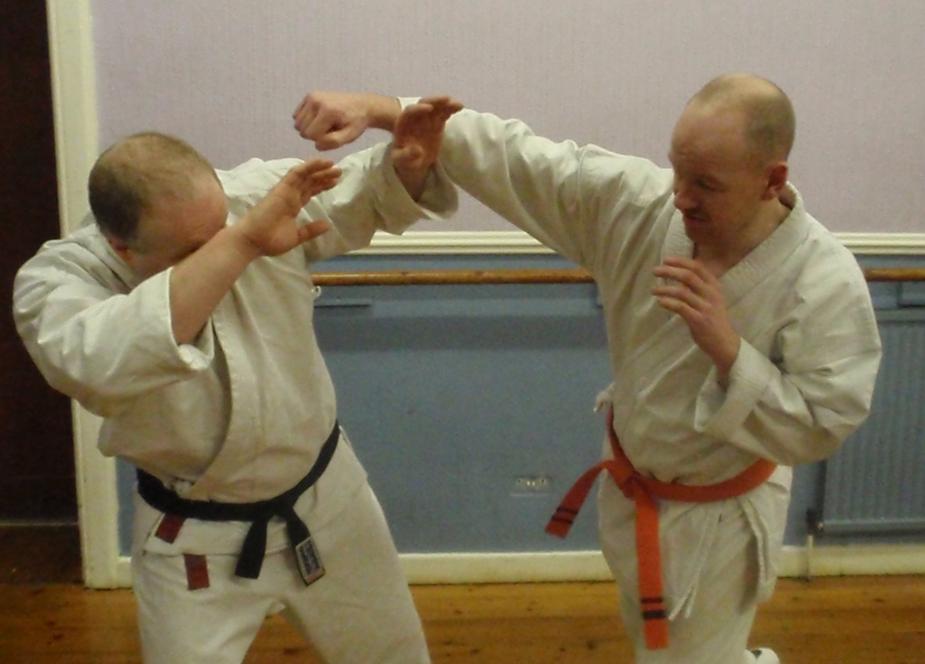
A defensive flinch
|
I have already discussed the power generation principles embodied in the rising block. Each method of getting the other hand into place has its own particular power generation principles. But why the differences in the actual technique? Why did one person think that they needed to practice one principle, and someone else another? What is the common thread that binds them together? My view is that this is where tactical principles provide an explanation. The important tactical principles I believe are inherent in this kata movement are:
- Get both hands up to protect your head – humans have an in-built flinch reflex when they see something rapidly approaching the head. This reflex consists of raising both arms towards or even to cover the head. If the reflex is strong enough it can also include hunching the shoulders and dropping the head down, away from danger. Even stronger and the legs will bend to remove the whole torso and head away from danger. Rather than try to deny this reflex it is better to build on it – ie. to build it into the way you respond.
- Attack and defend simultaneously – this builds upon the above flinch reflex but this time instead of passively defending, one hand can be used to go on the offensive. Either the attacking limb can be struck (eg. striking the bicep) as part of the ‘blocking’ action, or the head or torso can be struck.

Block and counter in one movement
|
What next?
As we have seen, it is possible to examine any kata and break down the movements to discover what principles of power generation they demonstrate. We may even be able to go further and identify tactical principles which the kata embodies. But what do we do with this knowledge? So far all we have are methods of generating power and a few tactics that may be of use in combat. This is only part of the picture. We now need to find a way to apply these principles in actual combat, ie. bunkai (and oyo). In the second part of this article I will explore not so much the different ideas for bunkai – other authors have addressed this at length – but rather how to test whether any bunkai is really of practical value.
References
- Suzuki T 1967 Karate-Do. Pelham Books Limited, London
- Dillman D, Thomas C 1994 Advanced Pressure Point Fighting of Ryukyu Kempo. Dillman Karate International, Reading